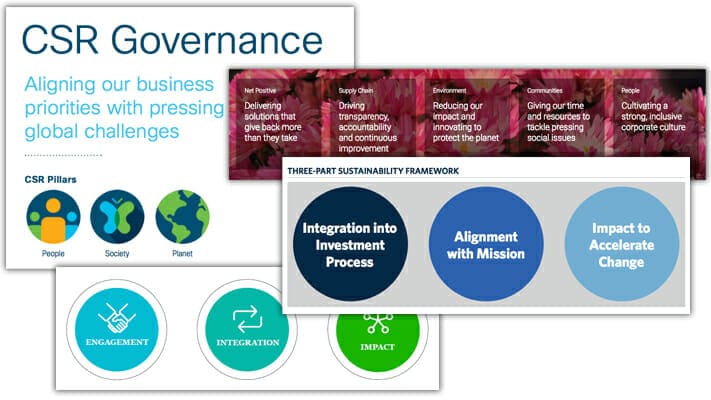Subscribe to Our Newsletter
Playwright Tom Stoppard once said, “Words are sacred…if you get the right ones in the right order, you can nudge the world a little.” We agree, especially when it’s time to discuss the good you do as acts of CSR (Corporate Social Responsibility).
We took a look at the annual CSR reports from several top B2B companies in an effort to track trends and assess common practices. And we couldn’t help but notice the multitude of acronyms and unfamiliar terms companies use to categorize and/or describe their philanthropic behavior.
From CSR to ESG (Environmental, Social and Governance) and SRI (Socially Responsible Investing), and from “mission” to “purpose,” the words can get tricky for readers and content creators alike to understand—especially when acronyms can be so easily confused with one another.
We’re here to bring clarity to CSR vocabulary so you can accurately communicate your company’s stance (or quickly grasp someone else’s).

CSR (Corporate Social Responsibility)
What is CSR? It’s most often used as an umbrella term for sustainability, corporate philanthropy and employee volunteerism initiatives. The language surrounding CSR can be used in various ways to highlight certain aspects of a CSR program.
CSR describes a company’s efforts to ensure its actions will have a positive impact on the business’s many audiences and every other entity in its ecosystem. It represents a commitment to go further than just follow the law; it details the extra effort the company makes to ensure the company’s interactions with employees, suppliers, customers and society at large are fair, respectful and charitable.
Although environmental considerations can be part of CSR, they are not CSR’s only focus. The “social” in CSR is indicative; at its root, CSR is about supporting and respecting a company’s employees, partners and external communities.
CSR is a good overarching term for companies to use when describing exemplary programs, behaviors and beliefs that benefit every brand constituency and/or the planet. Cisco and Dell are two major B2B companies that have prominently used the phrase to unite their community, environmental and employee support programs.
ESG (Environmental, Social and Governance) Criteria
What is ESG? First discussed in 2006 within the UN Principles for Responsible Investment (PRI), ESG criteria are measures by which companies and individual investors assess a firm’s commitment to its CSR goals. In short, they hold companies accountable for their CSR promises and help investors do market research.
ESG measures recognize that the safest investments are companies that act as good corporate citizens. So while they take into account the goodwill and positive results derived from responsible and philanthropic activities, they also value safety measures, environmental stewardship, prudent management practices and other policies that reduce risk.
Marketers can use ESG to describe a company’s transparent evaluation of its responsibility practices according to PRI principles. For example, JPMorgan Chase publishes an Environmental Social Governance Report that frames its high level sustainability policies for investors and the market.
PRI (Principles for Responsible investing)
What is PRI? In unique partnership with the UN, PRI is “the world’s leading proponent of responsible investment.” This leadership initiative publishes its “voluntary and aspirational” principles for institutional investors.
If a company becomes a signatory of the principles, it means they have committed to acting in accordance with them—either as an asset owner or manager or as a service provider. Signatories are responsible for providing a yearly assessment of their progress.
Being an active signatory of the PRI is an important mark of commitment, though it has more meaning in some contexts than others. In timberland investing (a space in which customers and investors are always concerned about reputational risk), participation could be considered table stakes.
While it shouldn’t be a central part of your CSR communications, any PRI affiliation should be mentioned as a proof point. For example, although the majority of the content in State Street Global Advisor’s Stewardship Report focuses on their actions—such as their Fearless Girl campaign—the company is clear that it built its programs purposefully to align with elements of the PRI.

SRI (Socially Responsible Investing)
What is SRI? SRI is the investment philosophy followed by those who are interested in using ESG criteria to evaluate a company’s CSR. Now that’s a mouthful!
Commonfund, a past DeSantis Breindel client, defines SRI as “investments driven first by ethical values.” These values are unique to each investor. Unlike the ESG criteria (which do not exclude investments from consideration but do rank them in accordance to adherence), SRI often involves negative screens; some investors may not want any investment in fossil fuels while others may draw the line at weapons.
SRI is still a very popular term, but we’ve noticed a trend toward simplification. Many companies that once used SRI now prefer to speak of RI (Responsible Investing). Perhaps these businesses grew tired of three-letter acronyms. Or maybe they wanted to indicate that their investment philosophy is sustainable across social, financial and environmental factors. Whatever the reason, RI is becoming increasingly recognized as a way to refer to ethically-motivated investment philosophies.
One company that has fully committed to RI is Nuveen, a TIAA-owned investment manager. Nuveen offers its clients a wealth of resources about RI strategies and benefits, ranging from reports on specific products to broader insights like market surveys.
Harness the Language of CSR to Connect with Every Audience
CSR communications are one of the best ways to showcase your company’s values, culture and commitment to responsible business practices. It’s also becoming increasingly important to share every initiative, as we see SRI being embraced by more and more investors—individual and institutional.
By understanding the “alphabet soup” of common acronyms and all they represent, you’ll be one step closer to creating messaging that can attract investors, build goodwill and secure loyalty. Every act of CSR is worth sharing. Simply and clearly.
To learn more about implementing the CSR language that’s right for your business, contact us.



